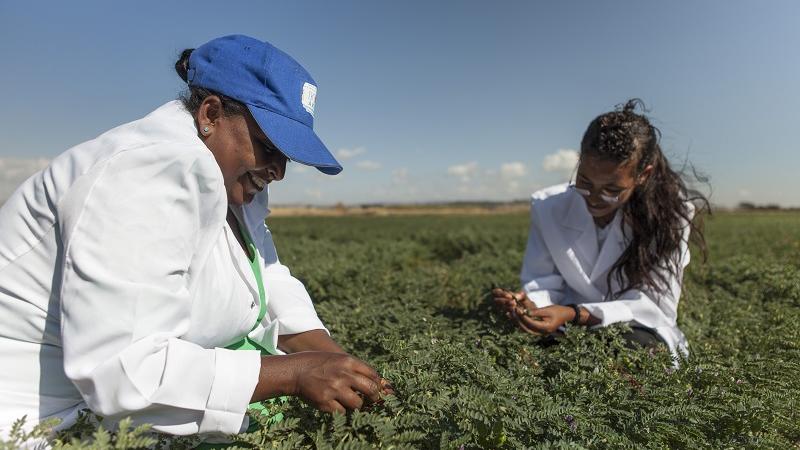Can improved cereal and legume varieties deliver for Sub-Saharan Africa?

ICARDA’s crop improvement program is testing and disseminating high-yielding, heat-tolerant and disease-resistant cereals and legumes. The varieties have the potential to transform agricultural productivity across sub-Saharan Africa – generating higher yields, improving livelihoods, strengthening food security and addressing climate change challenges.
Farmers in sub-Saharan Africa struggle to overcome multiple production constraints: a degraded natural resource base, chronic water scarcity, and a host of pests and diseases. Domestic production of staple crops such as pulses, wheat, and barley is limited – forcing the region to import food crops on a large scale. The result: a significant import burden that undermines national food security and exposes ordinary Africans to the vagaries of global commodity markets.
From its research hub in Ethiopia, ICARDA’s cereal and legume improvement program is attempting to reverse this scenario. Working with national partner the Ethiopian Institute for Agricultural Research (EIAR), and supported by USAID, the program aims to overhaul the productivity of the region’s strategic crops: wheat (bread and durum), barley (food and malt), kabuli chickpea, lentil, faba bean, and grass pea. The Program combines the development and/or testing of high-yielding and resilient crop varieties with capacity development and efforts to strengthen seed systems to ensure farmers have timely access to quality seed.
Developing, testing and disseminating the crops of the future
ICARDA develops region-specific crosses of crop varieties and sends early-segregated populations to Ethiopia for further evaluation and selection. Elite lines adapted to the region that demonstrate resistance or tolerance to abiotic and biotic stresses can then be constituted into regional nurseries and distributed to partners. ICARDA scientists also work with partners on the collection, acquisition, ex-situ conservation and regeneration of germplasm – the building block of crop improvement – to ensure posterity and the ongoing availability of genetic resources.
Since 2012, 30 improved varieties have been developed and released in Ethiopia and across sub-Saharan Africa. ‘Singitan’, for instance, an improved variety of malt barley, is higher-yielding than local varieties – generating up to 4.1 tons per hectare (t/ha) – and resistant to Shoot Fly, a major pest which causes crop losses of up to 100 percent during shorter rainy seasons. It also demonstrates superior malting qualities, making it an ideal raw material for Ethiopia’s growing malt beverage sector.
The benefits of improved malt barley varieties are acknowledged by farmers: “I have benefited a lot from barley production. We didn’t have money to spend before,” says Gosaye Degefa, a smallholder farmer from Ethiopia’s Oromia region. “We are now saving more money in the bank, and are able to send our children to school.” (Watch Gosaye’s story)
Improved wheat and barley lines show good adaptation to highland areas throughout East Africa. Food legumes have also performed well: promising lines of chickpea have been tested and identified in Sudan, and improved faba beans have successfully reduced the threat of common pests and diseases. The variety ‘Walki’, introduced alongside an integrated package of agronomic practices, has tackled Galls disease, and the variety ‘Hashenge’ has helped to control Orobanche, a parasitic herbaceous plant.
Improving farmer access to seed
The program has also strengthened seed systems to ensure that quality seed gets into the hands of farmers – ineffective seed systems in developing countries can be a major obstacle to higher productivity. The cereal and legume improvement program targets both formal and informal seed systems.
In the absence of a strong formal public or private sector, the key to enhanced adoption and diffusion of the newly improved varieties is mobilizing and engaging farmers in local seed entrepreneurship. This year, approximately 143 tons of chickpea, faba bean and malt barley seed have been distributed, and the program anticipates that an additional 3,309 tons of quality seed will be produced by farmers and seed producer cooperatives – enough to cover over 23,000 ha. In addition, the program is supporting seed policy, regulatory reform, and promoting harmonization to strengthen trade.
Capacity strengthening: investing now for tomorrow
Achieving long-lasting impact is dependent on raising capacity across the region’s agricultural sector – targeting farmers, extension agents, rural advisory services, and the leaders of seed-producing cooperatives. The program does this through field days, demonstrations and training courses.
Equipping cereal and legume producers with new knowledge and skills will ensure that sub-Saharan Africa can build on the progress already made so that the region can fight climate change and raise its cereal and legume productivity to become self-sufficient.
Some, however, believe the region should not be content with self-sufficiency: “What we see across the whole region is great potential,” says Zewdie Bishaw, Head of ICARDA’s Seed Unit, and currently leading the organization’s Sub-Saharan Africa Regional Program. “The potential to not only raise production and reduce import dependency, but also to go on from there and create a thriving export sector that delivers quality products to the world market.”
